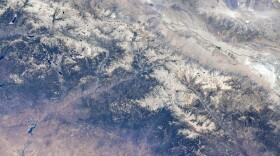For the first time, scientists at the University of Colorado Boulder have taken pictures of the sun’s middle corona, one layer of the solar atmosphere responsible for spitting out material known as solar flares. The images could improve space weather forecasting and how we prepare for it on Earth.
Like a rash, the sun occasionally flares up. Spots on its surface, and within its atmosphere, get brighter and hotter and can shoot plasma and magnetic fields outward in what’s called a coronal mass ejection, or CME.
According to Dan Seaton, a scientist at the Cooperative Institute for Research in Environmental Sciences at the University of Colorado Boulder, that creates space weather.
“We have the sun which we see in the sky, and then we have its atmosphere, the corona, which sort of just expands outward and fills the whole solar system,” he said. “We’re really living in the atmosphere of the sun all the time.”
Strong coronal mass ejections can destabilize entire power grids on Earth. Thirty years ago, a CME led to a blackout across the entire province of Quebec. In 1859, a famous space weather event actually caused telegraph equipment to catch on fire, Seaton said.
“The telegraph operators found that there was so much electrical current in the telegraph lines that they had to disconnect their batteries and just run on the power that was naturally flowing in the lines,” he said.
Technology has come a long way from the simple telegraph to the communication and GPS satellites now orbiting in space. And as technology progresses, the consequences of space weather will grow.
Tom Berger, director of the University of Colorado Boulder's Space Weather Technology, Research and Education Center, said radiation from solar flares disrupts and heats the Earth’s atmosphere.
“(GPS) signals have to go through the ionosphere before they reach the ground, so if the ionosphere is suddenly roiled up, turbulent, heated, expanded, those signals don’t really reach the ground as well as they would normally,” he said.
Because the atmosphere expands as it heats up, satellites that are normally in low Earth orbit can begin to feel more atmosphere than usual. That creates more drag, pulling them back, and can put them off course.
“Imagine if you have 10,000 Starlink satellites in your SpaceX constellation, suddenly they’re going to be moving around a lot relative to each other,” said Berger. “And in some cases, in past solar storms, satellites have moved so much that the tracking radar loses track of them.”
Extra solar radiation is also a problem that astronauts need to avoid, especially as humans begin to venture deeper into space. These consequences make it crucial to accurately predict when the sun might expel a CME, but current models for space weather forecasting have a lot of gaps.
“The equivalent would be just standing on a beach in Hawaii and telling people when the hurricane comes to shore, ‘Oh, the hurricane’s here,’” said Berger. “Well, that’s great, but we would've liked to have known when it was coming in.”
The 2018 images from CU Boulder scientist Dan Seaton and his team are a step in the right direction. Taking the pictures was tricky — they needed to look away from the brightest parts of the sun, but also capture enough light from the atmosphere to take good measurements.
“We took one of these (National Oceanic and Atmospheric Administration) telescopes that’s traditionally meant to be aimed right dead center at the sun, and we turned it to the side,” Seaton said. “We gathered light for a really long time, and we were actually, sort of surprisingly, after much image processing, able to observe this region of the sun’s atmosphere that nobody’s really looked at in detail before.”
After about two years of processing and analysis, the images backed up some of what the scientists already knew about CMEs. But what they didn’t anticipate seeing were areas where solar material was flowing back into the sun.
“That’s a big surprise because people have always sort of assumed that all of the dynamics of the sun are driven from below, from inside the part of the sun that we don’t see, which is very energetic and very hot and sort of full of some boiling motions that stir things up,” Seaton said. “And this reveals that, at least to some extent, there’s also driving from above.”
For space weather expert Tom Berger, the new observations provide additional evidence on how CMEs form.
“Previously, we could only see the CME after it had left the sun, quite a while ago,” he said. “With this result, we can see all the way down to the surface of the sun, we can see the CME developing in an earlier phase.”
Berger said that view will help scientists make better computer models of the sun. And as these models improve, so will predictions of incoming space weather events.





